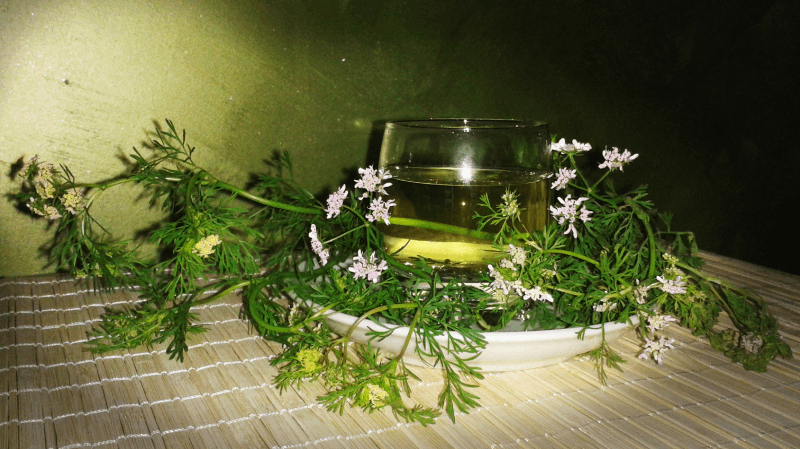Sometimes it’s the smell, sometimes it’s the look. This little light purple flower surrounded by little needle leaves and some larger delicate leaves intrigued our little bat! Firstly, let’s get the facts straight, this plant in some countries it’s referred to as cilantro while in other countries it’s known as coriander. This infusion can be done both with the seeds of the plant (known as coriander where the plant is known as cilantro) or with the actual leave, stems, and flowers. The flavor is slightly different but very similar, it is the same plant after all, and it is all edible. So, let’s take a closer look at this beautiful, delicate herb!
What is Coriander?
This is another herb from the Apiaceae family (same as dill, fennel, celery, parsley, and even carrots!) that is also known as Chinese parsley and dhania (besides cilantro or coriander! Just for simplicity, I will be using coriander to refer to the whole plant since it’s a term used to refer to cilantro or the seed from this herb in many countries. It is also how we refer to this herb in my country, so it will be easier for me.) All parts of this plant are edible but the leaves (used as herbs) and the seeds (used as spices) are the most commonly used. Coriander is widely spread and commonly found in Southern Europe, Northern Africa, and Southwest Asia. It is also very commonly used in Latin American dishes as well as Asian cuisine. This herb can grow up to 50cm tall with broadly lobed leaves at the base of the plant and slender and feathery ones on the flowering stems. This delicate plant has been cultivated, or exported since ancient Egyptian times since it was found in some tombs there although it doesn’t grow wild in Egypt!
Coriander leaves are mainly composed of water, however, are particularly rich in Vitamins A, C, and especially Vitamin K. The seeds on the other hand have a lower vitamin content, however, they provide a higher amount of dietary fiber, calcium, selenium, iron, magnesium, and manganese than the leaves do.
Health Benefits
Coriander as a plant is mostly rich in Vitamin K which is the key vitamin responsible for bone metabolism, regulating blood calcium levels, and blood clotting, therefore, if you are on any blood thinners consult your doctor before starting any regular consumption of coriander (especially leaves or cilantro)! Also, remember that while the leaves are richer in Vitamins, the seeds are a better mineral supplement so mix both for best health benefits (and flavors since they are slightly different in tastes as well)! So let’s list some benefits this herb is known for.
- Improves digestion and soothes digestion problems
- Helps against skin problems like eczema, rashes, and mouth ulcers
- Promotes good cholesterol balance
- Helps to regulate blood sugar levels
- Promotes stronger and fuller hair
- Rids the body of heavy metals
- Prevents inflammations
- Protects against cancer
- Antifungal properties
- Improves sleep and may help against anxiety
- Provides pain relief
- Supports a healthy menstrual cycle
- Promotes healthy eyes
Side Effects
As always, we will also take a look at the less positive side of this herb. As we’ve seen before coriander might interact with blood thinners, so be extra careful if you are taking any such medication. It is also not ideal to use coriander when you are on medication that increases photosensitivity (sensitivity to sunlight, as in large dosages coriander can also increase this). We always recommend discussing with your doctor whenever you decide to make a major change in your diet especially if you do have any conditions, even though the effects might be beneficial for you, it’s always better to discuss and be safe, right? Coriander might also cause allergic reactions, so let’s list the symptoms you need to keep an eye for.
- Asthma
- Nasal swelling
- Hives
- Mouth swelling
- Itching
- Rashes
Making the Tea
- 1 teaspoon coriander seeds
- 1 cups of water
As usual, making this infusion is extremely simple, basically like almost all of our simple infusions. Just bring your water to a boil, wait for a couple of seconds for the water to settle down, and add the coriander seeds. Wait for it to seep and your infusion is done! You can also use cilantro (the leaves, stems, and flowers), however, you need way more than a teaspoon to get some good flavor, it has a lovely, fresh, but very light flavor! Of course, you can adjust the seeping time and the amount of coriander you add according to your taste, longer and more herbs for a stronger flavor, and shorter or fewer herbs for a lighter tisane. You may add parsley to your infusion both for flavor and for more purifying health benefits. Ginger is another good option, especially if you are fighting a cold. Another interesting recipe is Koththamalli (Sir Lankan/Ceylon style), basically, you start by roasting the seeds before letting them simmer in water, ginger or honey is usually added to this recipe as well! Coriander is also great as an addition to your usual cup of tea! Let us know what you think of this herb and if you have any other infusion you would like us to sniff around, leave a comment below!

